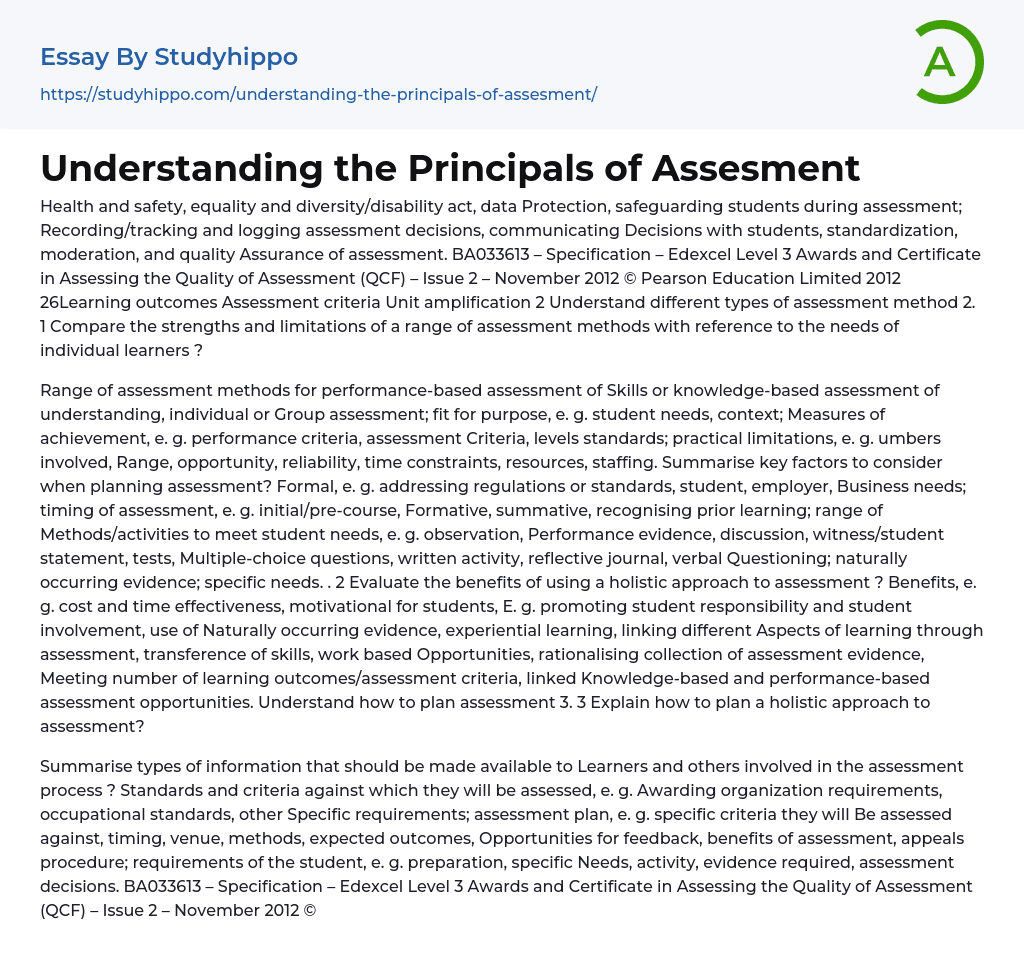Health and safety, equality and diversity/disability act, data Protection, safeguarding students during assessment; Recording/tracking and logging assessment decisions, communicating Decisions with students, standardization, moderation, and quality Assurance of assessment. BA033613 – Specification – Edexcel Level 3 Awards and Certificate in Assessing the Quality of Assessment (QCF) – Issue 2 – November 2012 © Pearson Education Limited 2012 26Learning outcomes Assessment criteria Unit amplification 2 Understand different types of assessment method 2. 1 Compare the strengths and limitations of a range of assessment methods with reference to the needs of individual learners ?
Range of assessment methods for performance-based assessment of Skills or knowledge-based assessment of understanding, individual or Group assessment; fit for purpose, e. g. student needs, context; Measures of achievement, e. g. performance criteria, assessment Criteria, levels standards; practical limitations, e. g. umbers involved, Range, opportunity, reliability, time constraints, resources, staffing.
...Summarise key factors to consider when planning assessment? Formal, e. g. addressing regulations or standards, student, employer, Business needs; timing of assessment, e. g. initial/pre-course, Formative, summative, recognising prior learning; range of Methods/activities to meet student needs, e. g. observation, Performance evidence, discussion, witness/student statement, tests, Multiple-choice questions, written activity, reflective journal, verbal Questioning; naturally occurring evidence; specific needs. . 2 Evaluate the benefits of using a holistic approach to assessment ? Benefits, e. g. cost and time effectiveness, motivational for students, E. g. promoting student responsibility and student involvement, use of Naturally occurring evidence, experiential learning, linking different Aspects of learning through assessment, transference of skills, work based Opportunities, rationalising collection of assessment evidence, Meeting number of learning outcomes/assessment criteria, linked Knowledge-based and performance-based assessment opportunities. Understand how to plan assessment 3.
Explain how to plan a holistic approach to assessment?
Summarise types of information that should be made available to Learners and others involved in the assessment process ? Standards and criteria against which they will be assessed, e. g. Awarding organization requirements, occupational standards, other Specific requirements; assessment plan, e. g. specific criteria they will Be assessed against, timing, venue, methods, expected outcomes, Opportunities for feedback, benefits of assessment, appeals procedure; requirements of the student, e. g. preparation, specific Needs, activity, evidence required, assessment decisions. BA033613 – Specification – Edexcel Level 3 Awards and Certificate in Assessing the Quality of Assessment (QCF) – Issue 2 – November 2012 © Pearson Education Limited 2012 28 Learning outcomes Assessment criteria Unit amplification 4. 3 Explain how peer- and self-assessment can be used effectively to promote learner involvement and personal responsibility in the assessment of learning? Peer feedback, e. g. ormal or informal, witness statements, peer Observations, feedback, working collaboratively, sharing goals, Targets, giving and receiving feedback, awareness of risks of Appearing challenging or confrontational; formal or informal self-assessment, E. g. SAR (Self-Assessment Review), initial assessment, current knowledge, understanding, skills, occupational competence, SWOT (strengths, weaknesses, opportunities and threats), reflection, Identifying targets, target setting, and action plans. Explain how assessment arrangements can be adapted to meet the needs of individual Learners.
Negotiating assessment needs with individual students, e. g. Identifying specific learning/assessment needs, range of assessment Methods, activities to meet different student/context/needs, Alternative assessment activities where appropriate, repeating Assessment to provide opportunity for experiential learning, use of Alternative assessor, learning support, discussion to supplement Primary evidence; recording evidence of assessment to suit student Needs, e. g. digital recording, audio/visual, scribe.
- Academia essays
- Higher Education essays
- Language Learning essays
- Studying Business essays
- Education System essays
- Study essays
- First Day of School essays
- Scholarship essays
- Pedagogy essays
- Curriculum essays
- Coursework essays
- Studying Abroad essays
- Philosophy of Education essays
- Purpose of Education essays
- Brainstorming essays
- Educational Goals essays
- Importance Of College Education essays
- Brown V Board of Education essays
- The Importance Of Higher Education essays
- Online Education Vs Traditional Education essays
- Academic And Career Goals essays
- Academic Integrity essays
- Brown Vs Board Of Education essays
- Distance learning essays
- Technology in Education essays
- Vocabulary essays
- Writing Experience essays
- Importance of Education essays
- Early Childhood Education essays
- Academic Degree essays
- Academic Dishonesty essays
- School Uniform essays
- Academic writing essays
- Cheating essays
- Bachelor's Degree essays
- MBA essays
- College Life essays
- Grade essays
- Diploma essays
- Phonology essays
- Sentence essays
- Filipino Language essays
- Pragmatics essays
- Millennium Development Goals essays
- History Of Education essays
- Graduate School essays
- Middle School essays
- School essays
- Special Education essays
- University essays




